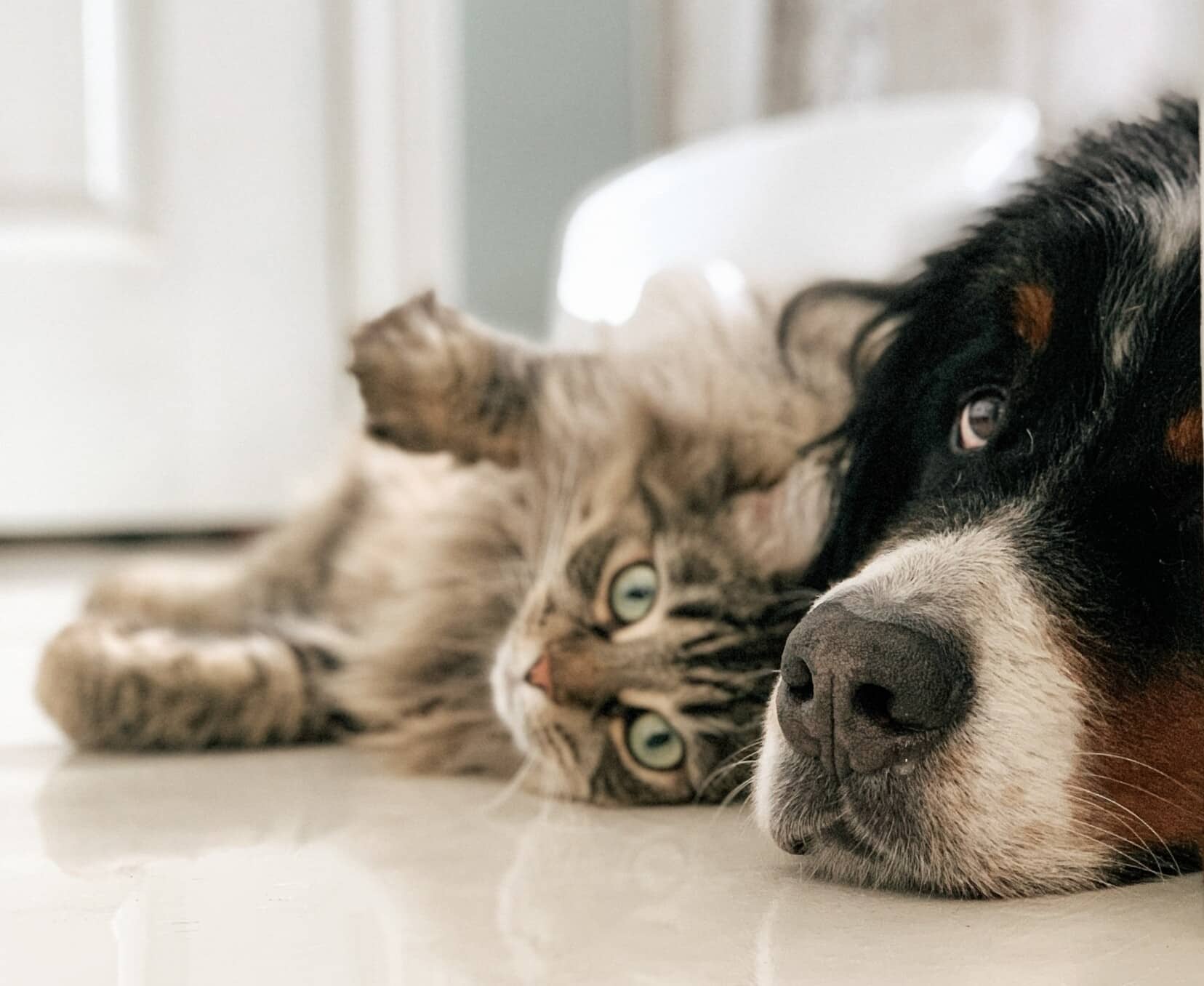Dog vs. Cat – Which Pet Suits You & Your Lifestyle
Pets are a beloved part of every family that has them. Dogs, cats, birds, reptiles, or small animals—the choices we have for what kind of pet to bring into our lives are almost endless. Selecting your perfect companion depends on your preferences, personality, lifestyle, and family dynamics. And without a doubt, the top two contenders for being your furry friend are cats and dogs. But which pet better suits you and your lifestyle?

Read on for information on cats and dogs and which pet will be a better fit for you.
Cats and Dogs
According to the American Veterinary Medical Association, the US’s most common pets are cats and dogs, with 38.4% of households owning dogs and 25.4% own cats. It’s a tough decision and one that cannot be based upon cuteness alone! In general, because cats and dogs have such different needs and characteristics, your decision is greatly influenced by the type of lifestyle you have. Dogs do require more attention, whereas cats are more independent. You need to consider your activity levels, the available space you have in your home, your family dynamics, and how much time you have to devote to your pet.
Aspects of Having a Pet Dog
Dogs are one of the most common pets for American households but also need more interaction and space. Because of the incredibly tight bonds dogs will form with their families, they are a popular choice for long-term companions. But here are some other considerations for owning a dog:
Adaptability
Many dogs tend to accept change and alter their daily routines easily, particularly when their owners help them through it. Of course, some dogs are more anxious than others, but, as a species, dogs are often calmer and more accepting of alterations to their home, family, and lifestyles. This can be especially useful when introducing new people, pets, items, or living circumstances to your dog—they will adapt and be more trusting faster than other types of pets. Because most dogs take their cues from their owners, you will need to remain calm and act like it is no big deal.
Energy and Exercise
Because of dogs’ higher energy levels, they need a more “outdoorsy” type of owner who loves to keep active. If you are someone who spends plenty of time exercising, adventuring, and generally keeping busy, a dog might be the right choice for you. Dogs require high amounts of stimulation, fresh air, and regular exercise, so they are suited to people who have access to a garden or backyard, live in rural areas, or have available access to open spaces and pet-friendly parks.
Living Conditions
Dogs can be indoor or outdoor pets, but because they are generally more hyperactive and need more space, some dogs may have more difficulties with staying inside—especially when it comes to larger breeds.
Life Expectancies
The lifespan of dogs does vary according to full-grown size, breed, and pre-existing health conditions. But we can generalize the typical life expectancies of dogs into a few categories:
- Smaller dogs, like terriers and miniature breeds, often live up to 14 or 15 years and sometimes older.
- Medium and large dogs, like retrievers and spaniels, can live between 10 to 13 years.
- Giant dog breeds, like mastiffs and wolfhounds, often only live to 7 or 8 years old.
Playtime
It’s no secret that dogs love to play, and more importantly, they love to play with you. Fetch, tug-of-war, chase games, play wrestling, and more, dogs thrive on interactive play. It stimulates their minds and instincts, exercises their muscles, and gives them much-needed space to blow off steam and get all the zoomies out. If your dog gets along with other canines well, you can set up a doggie playdate and get some owner-to-owner socialization time for yourself!
Protection
Because dogs are instinctually defenders, it is in their nature to protect you and your home. They will bark or growl to alert their owners of stranger danger or intruders. Dogs can also sense fear and respond when they believe their owners feel threatened or nervous.
Training
Dogs are among the easiest pets to train. Not just because they are commonly food-motivated, but most dogs enjoy the act of being trained and learning new abilities and tricks. It seems to give dogs a sense of purpose, not to mention a delicious treat or attention after performing a job or trick. Because some dogs tend to misbehave when they are bored, giving them a task exercises and mentally stimulates them and provides them a sense of pride.
Downsides to Dogs as a Pet
- As a whole, dogs tend to cost more to take care of—the ASPCA averages total dog care costs to be between $1,400 and $2,000 per year, depending on the size and general health of the breed. So, you will need adequate funds to cover the basic costs of dog ownership and emergency contingencies.
- Because of the high energy levels of dogs, you will need to devote a vast amount of your time to exercising, training, and socializing your dog. If you work long hours, are not home much, or do not particularly enjoy getting out and about in the outdoors, a dog might not be the best match for your lifestyle.
- If you travel frequently and cannot take your dog with you, pet boarding can get quite expensive and lonely for your pet.
- The general daily care routine for dogs comes with greater responsibility—they require grooming, nail trimming, exercising, feeding, stimulation, and more.
Aspects of Having a Pet Cat
While the independent nature of cats sometimes makes them seem less enjoyable as a pet, it’s important to remember that all animals have very different personalities. Cats can develop extremely strong bonds with their people and entertain owners with their antics. Here are some things to consider before welcoming a cat into your home:
Affection
It’s a common myth that cats are not affectionate creatures. But cat owners around the world would vehemently contest that statement—cats may not be as openly lovey as dogs, but once you earn the affection of your cat, they will be the ultimate companion for life. Even if you need to work for their fondness, most people can agree that a cuddle session with your purring pet cat is one of the best feelings.
Daily Requirements
Because cats are very self-sufficient, they don’t require too much care from their owners on a daily basis. Cats relieve themselves in their litter boxes, groom and clean themselves regularly, and don’t need their owners for many everyday tasks aside from feeding. Cats also tend to be less odorous and make smaller messes. Because cats spend so much of their days dozing, up to around 15 hours a day, they are less fussy when it comes to daily caretaking.
Expenses
On average, cats incur less monetary expenses. With veterinary costs, food, accouterments, and other bills, annual fees for owning a cat will total around $1,200 according to the ASPCA’s pet care costs breakdown. So, if you are looking at pets from a financial standpoint, becoming a cat owner is the less expensive option. Of course, you always need to set aside funds for any emergency procedures because cats can develop severe health issues requiring immediate veterinary attention.
Life Expectancies
Cats, and especially indoor cats, live for a longer span than dogs. A pet feline will likely live for 10 to 15 years. Some have been known to live up to 25 years with proper care and love. So, if you are looking for a furry companion that will be in your life for a long time, cats are a good option.
Noise Levels
Compared to other household pets, cats are typically very quiet. Though some can be more talkative, cat vocalizations tend to be softer—purrs, meows, and chirps. You can even learn how to identify your cat’s particular communications, differentiating the “I’m hungry” meows from the “cuddle me” meows.
Social Upkeep and Time
Cats require attention from their owners but are not as active as dogs. Thus they do not need as much interaction or physical exercise. Cats are independent creatures and often will entertain themselves rather than seeking you out to play. That being said they do not need constant attention or supervision. However, some cats are very interactive and love nothing more than chasing lights, feather toys, or other forms of person-led entertainment.
Space Considerations
Because cats are primarily indoor pets, they do not require outdoor spaces to roam around. They also don’t need as much indoor space either—cats tend to be content with appropriate toys, scratching posts, beds, litterbox, and areas of the house to hang out. Cats’ hunting instincts will cause them to stalk their prey (toys) and leap onto heights (cat trees), so they don’t require much room to roam. Some cat owners find that a large house leads to losing your cat for a while because they are great at playing hide-and-seek.
Downsides to Cats as Pets
- Cats can become quite rambunctious, and with their sharp little claws, your furniture might get the brunt of their energy bursts. You will also likely experience some small scratches or wounds if your cat gets overexcited, or someone is not respecting their boundaries. But luckily, they don’t do too much damage.
- Being very strong-willed and independent, cats are harder to train than dogs, and obeying commands is not a strong suit for any felines.
- Because cats are primarily nocturnal by nature, you may be woken up during the night or early morning by insistent meowing or demands for food. And because they sleep most of the day, your preferred interaction or playtime schedule might not fit with your cat’s.
The Perks of Being a Pet Owner
Cuddles and playtime are not the only perks of having pets. Studies have shown that pet owners have lower cholesterol levels and lower blood pressure. They are also less likely to suffer from things like anxiety, depression, and stress. A study by Harvard University revealed that having a pet in your life can significantly improve the chances of surviving a heart attack. Additionally, a study in the UK found that people who own pets can deal with the stress surrounding a loss better than pet-less individuals.
Between cats and dogs, the enjoyment and fulfillment you will experience from their companionship and love are the same. Both animals become fast members of your family and an essential part of your life. And with the wide variety of breeds, temperaments, shapes, and sizes of both cats and dogs, your options for bringing a new furry friend into your life are nearly endless. For more information on breeds and their personalities, check out Purina’s dog breed library and cat breed library.




There are no comments
Comments are closed.